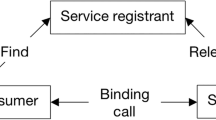Abstract
The traditional music teaching model cannot meet the needs of modern music teaching. Therefore, this paper combines machine learning technology and Internet of Things audio technology to improve the music audio recognition algorithm. In order to ensure the smoothness between music frames and the continuity of speech, when the remaining length of the music audio stream tail is less than one frame length, it is directly discarded and no framing processing is performed. The main end of the integrated platform can communicate with the sub-end systems of each smart music classroom through a standard communication protocol by the front communication server, and access the information and data of each device subsystem in the smart music classroom. In addition, this paper combines the needs of music teaching to construct the layout of the smart music classroom and the software system architecture. After constructing the system, this paper designs experiments to verify the performance of the teaching system constructed in this paper. The experimental research results show that the audio technology based on the Internet of Things proposed in this paper can play an important role in music teaching.















Similar content being viewed by others
References
Qu Y, Yu S, Zhou W et al (2018) Privacy of things: Emerging challenges and opportunities in wireless internet of things[J]. IEEE Wirel Commun 25(6):91–97
Dash D, Farooq R, Panda JS et al (2019) Internet of Things (IoT): the new paradigm of HRM and skill development in the fourth industrial revolution (industry 4.0)[J]. IUP J Inf Technol 15(4):7–30
Chin J, Callaghan V, Allouch SB (2019) The Internet-of-Things: reflections on the past, present and future from a user-centered and smart environment perspective[J]. J Ambient Intell Smart Environ 11(1):45–69
Bedi G, Venayagamoorthy GK, Singh R et al (2018) Review of Internet of Things (IoT) in electric power and energy systems[J]. IEEE Internet Things J 5(2):847–870
Bisio I, Delfino A, Grattarola A et al (2018) Ultrasounds-based context sensing method and applications over the Internet of Things[J]. IEEE Internet Things J 5(5):3876–3890
Chamberlain A, Bødker M, Hazzard A et al (2017) Audio technology and mobile human computer interaction: from space and place, to social media, music, composition and creation[J]. Int J Mob Hum Comput Interact (IJMHCI) 9(4):25–40
Kiliç DBÇ (2017) Pre-service music teachers’ metaphorical perceptions of the concept of a music teaching program[J]. J Educ Learn 6(3):273–286
Hoffman DL, Novak TP (2018) Consumer and object experience in the internet of things: an assemblage theory approach[J]. J Consum Res 44(6):1178–1204
Jia B, Hao L, Zhang C et al (2019) An IoT service aggregation method based on dynamic planning for QoE restraints[J]. Mob Netw Appl 24(1):25–33
Waldron J, Mantie R, Partti H et al (2018) A brave new world: theory to practice in participatory culture and music learning and teaching[J]. Music Educ Res 20(3):289–304
Zhang J, Tao D (2020) Empowering things with intelligence: a survey of the progress, challenges, and opportunities in artificial intelligence of things[J]. IEEE Internet Things J 8(10):7789–7817
Melchiorre AB, Rekabsaz N, Parada-Cabaleiro E, Brandl S, Lesota O, Schedl M (2021) Investigating gender fairness of recommendation algorithms in the music domain. Inf Process Manag 58(5):102666
Muhammad G, Rahman SKMM, Alelaiwi A et al (2017) Smart health solution integrating IoT and cloud: a case study of voice pathology monitoring[J]. IEEE Commun Mag 55(1):69–73
Shengmin X (2017) Analysis on the innovative strategy of national music teaching in colleges from the perspective of visual communication[J]. Stud Sociol Sci 7(6):52–55
Herremans D, Chuan CH (2020) The emergence of deep learning: new opportunities for music and audio technologies. Neural Comput Applic 32:913–914
Kim SK, Sahu N, Preda M (2017) Beginning of a new standard: internet of media things[J]. KSII Trans Internet Inf Syst 11(11):5182–5199
Kaplan A, Haenlein M (2019) Siri, Siri, in my hand: who’s the fairest in the land? On the interpretations, illustrations, and implications of artificial intelligence[J]. Bus Horiz 62(1):15–25
Reyes FL (2017) A community music approach to popular music teaching in formal music education[J]. Can Music Educ 59(1):23–29
Jones VK (2018) Voice-activated change: marketing in the age of artificial intelligence and virtual assistants[J]. J Brand Strategy 7(3):233–245
Aithal PS, Aithal S (2019) Management of ICCT underlying technologies used for digital service innovation [J]. Int J Manag Technol Soc Sci (IJMTS) 4(2):110–136
Johnson C (2017) Teaching music online: changing pedagogical approach when moving to the online environment[J]. Lond Rev Educ 15(3):439–456
Lin PL (2019) Trends of internationalization in China’s higher education: opportunities and challenges[J]. US-China Educ Rev B 9(1):1–12
Hong SY, Hwang YH (2020) Design and implementation for iort based remote control robot using block-based programming[J]. Issues Inf Syst 21(4):317–330
Bayley JG, Waldron J (2020) “It’s never too late”: Adult students and music learning in one online and offline convergent community music school [J]. Int J Music Educ 38(1):36–51
Luque-Vega LF, Lopez-Neri E, Santoyo A et al (2019) Educational methodology based on active learning for mechatronics engineering students: towards educational mechatronics [J]. Computación y Sistemas 23(2):325–333
Powell B (2019) The integration of music technology into popular music ensembles: perspectives of modern band teachers [J]. J Technol Educ 12(3):297–310
Acknowledgements
This work was supported by the 2020 National Social Science Fund Project “China’s 70 years National Spiritual Shaping and Communication of Patriotic Songs” (No. 20BXW010).
Author information
Authors and Affiliations
Corresponding author
Ethics declarations
Conflict of interest
The authors declare that they have no conflict of interest.
Additional information
Publisher's Note
Springer Nature remains neutral with regard to jurisdictional claims in published maps and institutional affiliations.
Rights and permissions
About this article
Cite this article
Li, L., Han, Z. Design and innovation of audio IoT technology using music teaching intelligent mode. Neural Comput & Applic 35, 4383–4396 (2023). https://doi.org/10.1007/s00521-022-07025-7
Received:
Accepted:
Published:
Issue Date:
DOI: https://doi.org/10.1007/s00521-022-07025-7




